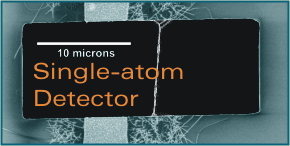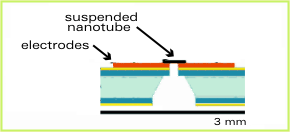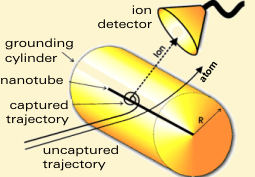Single-Atom Detector
| We are conducting experiments that use a carbon nanotube as a detector for individual neutral atoms. This builds on earlier work in our group, where we began studying this atom-wire problem. In our 2005 publication, we show that the high electric field near a charged carbon nanotube is sufficient to field ionize atoms. These ions are easily detected with an electron-multiplier, placing the charged nanotube at the heart of this novel single-atom detector. Beyond simple detection, the device is predicted to yield striking quantum phenomena that are only accessible at low temperatures and small length scales. |
  |
 |
The induced dipole interaction attracts an atom to the charged nanotube. If the energy associated with this interaction is the dominant force in the atom's trajectory, it will be pulled into the strong electric fields around the nanotube. The angular momentum L of the atom determines its fate: if L is large, the atom escapes, but if L is too small the atom descends into an electric field that is strong enough to rip the atom apart. Since wave mechanics and classical mechanics lead to dramatically different predictions of the critical value of angular momentum, separating escape from ionization, the two theories lead to disparate atom dynamics. This difference is revealed in the most basic operation of the detector: how many atoms are ionized for a given charging voltage. As a function of voltage, the capture rate for atoms is expected to increase in discrete steps. |
| We have also considered several other possibilities that exist for the atom-wire system. These include the possibility for atomic traps where the atom makes a stable orbit around the tube, in contrast to the trajectories discussed above which are only pulled into the tube or pushed away. These devices could be used as atomic waveguides. The physics of the basic atom-nanotube interaction remains to be studied. For example, what role do van der Waals forces and atom-atom interactions play? Extending the experiments to atoms that are optically pumped to lower ionization energy or more polarizable states is also particularly exciting. Lastly, the energy of the ejected ions will reflect the details of the ionization process. Higher energy ions originate closer to the tube. The ion energy spectra will also depend on the nanotube's electronic and structural features for which cold atoms may provide the ideal probe. | |
|
For more information, see our publications:
Anne Goodsell, Trygve Ristroph, J.A. Golovchenko, and Lene Vestergaard Hau Lene Vestergaard Hau, B. D. Busch, Chien Liu, Michael M. Burns, J. A. Golovchenko Lene Vestergaard Hau, J. A. Golovchenko, and Michael M. Burns Lene Vestergaard Hau, Michael M. Burns, and J. A. Golovchenko |
|